We independently evaluate all recommended products and services. Any products or services put forward appear in no particular order. If you click on links we provide, we may receive compensation.
As every reviewer has the obligation to say, “What iiiiiiis up, guys?!”. In an ode to Ben Petersen, former marketing guy at BladeHQ, I just feel the need to throw out the infamous intro he used in Knife Banter YouTube series. Ben definitely had his hands on more knives than most of us ever will, and with the 8 years of industry networking, he teamed up with WE Knife to make his personally designed knife, the Banter.

What we’re seeing here is another step forward towards increased democratization of an industry that was once dominated by a handful of giant players. Of course it’s one thing to bring a knife to market but it’s another to have it be a success. A quality product obviously helps but the marketing effort plays a role here too and Ben is no stranger to that.
Key Specs: WE Knife Banter
Sure enough, the Banter is more than just another folder to check out and pass around. It’s one that proves that when you put serious dedication into a dream, it can be accomplished. This knife has the utmost simple design, but that doesn’t mean it’s lacking the attention needed to make a good, solid knife. It has some nuances and attention to detail that gives it the muster it needs, to become a complete package that’s very usable and friendly to carry. Let’s have some small talk, some repartee, some banter about a little knife that could, and see what it’s hiding in it’s modest little package.
The Blade
The Banter’s blade is beautifully simple. It’s a classic spear point, with a high grind coming to a saber style termination just before the spine. The blade stock thickness is modest, too, at .10”. Coupled with a behind-the-edge thickness of around .017’, it’s a great little slicer. Our example of the Banter is boasting the DLC stonewashed blade, which looks great, and hides use very well. 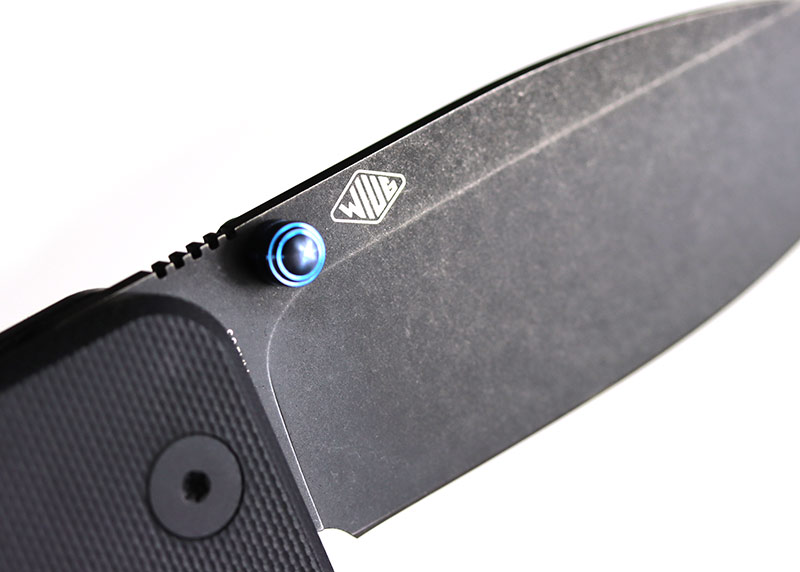
The black bladed version also carries the design language to the handle scales, with black G-10. Some DLC coatings, while still very strong, can show smudges and scratches pretty easily. With the stonewashing on the Banter, it all looks uniform, albeit slightly worn in. The satin version of the knife, which has the blue handle scales and black thumb studs, is stonewashed for the same reasons.
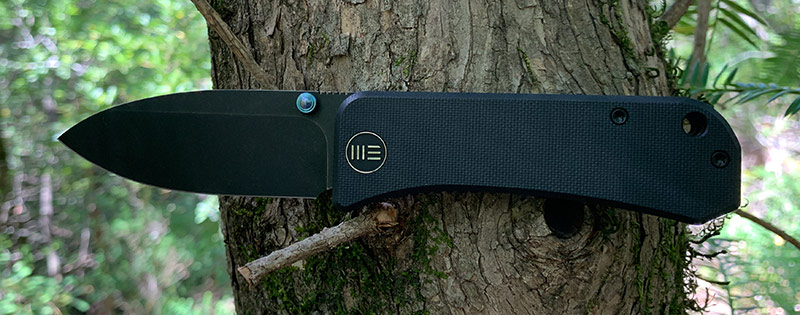
With 2.9” of CPM-S35VN blade steel, you’ll be packing a very usable EDC knife in your pocket. Most of us know this blade steel well as it’s used on an extremely high number of production and even custom knives, from Demko, to Chris Reeve, to Cold Steel, to Spyderco, just about every popular knife name has made some of their models in this steel. And there’s a good reason for it. It’s stainless, fairly easy to sharpen, takes a good working edge, and is tough enough for just about anything a folding knife is typically designed to do. So, the choice in steel is nothing profound here, but it’s fitting. And you won’t forget which steel is used on the blade, since it’s etched in, along with Ben’s maker’s mark, WIUG (yes, really, the “What Is Up Guys” acronym is the designer’s mark – awesome). And, with a gentle touch of jimping on the spine, we round out the most simple blade that’s been put on a folder since sliced bread.
Deployment/Lockup
When I pick up a new folder, one of the first things that I look for is detent rock. It seems to me, like when a manufacturer puts enough attention into their folder to keep the blade closed tightly, it’s a first impression that can’t be overlooked in my book. And the Banter has the most finely tuned detent I’ve seen on a pocket knife in this price range (a very fair ~$108). Giving the thumb studs a gentle flick from either side of the knife, sends the blade to it’s open position with the kind of authority we all hope to feel and hear. Again, surprising for this price point of folder.
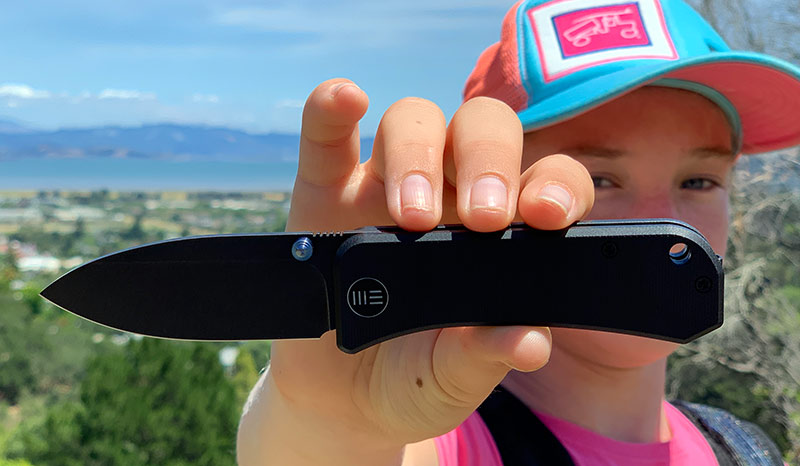
And, unlike some higher end knives (sorry Tim and Company at CRK, the Sebenza thumb stud is just a rounded spike), we have a very generously sized and comfortable deployment method. It’s a knife that’s just fun to flick open. We’ll dig a little deeper into the knife’s features later in the review, but with the blade coasting along bearings (yes, no washers here), it really just feels effortless to deploy. That is not an easy feat; to have a blade that’s held in the handle tightly, but flicks out effortlessly. Great job, Ben and WE Knife.
And, once that blade is locked open, it is truly positive in feel. I’ve handled more knives than I would care to count, from $5 to $1,000, and the Banter locks up with solidity only comparable to my personal favorite, the Spyderco Gayle Bradley 1 (what an amazing knife, by the way. Long time discontinued classic). Again, very surprising at just over $100. I cannot muscle any blade play side to side, or up and down, whatsoever. This is, again, a very difficult status to achieve in a folder, no matter who the maker is. And, the lockup position of the liner does not change with different levels of force in opening the knife.
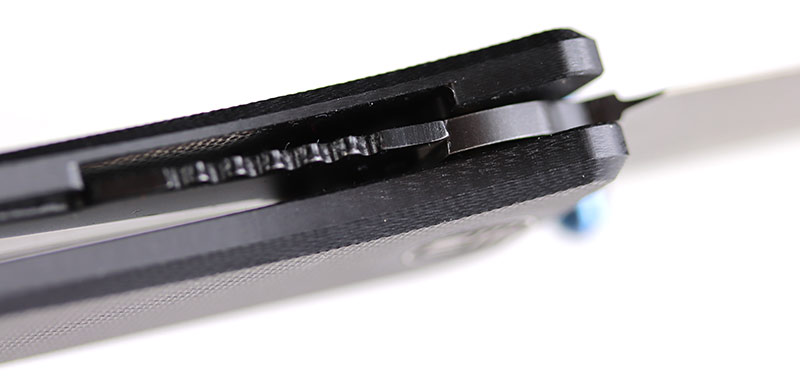
I remember my Microtech Socom Elite, if opened slowly, the liner would engage early on the blade. If flicked open with some authority, the liner would jump to a much later portion of the blade tang. Not the case here, the Banter liner lock sits at the same spot every time, regardless of the force being used to deploy the blade.
But, and yes, there’s a but… the liner lock is protruding proud of the handle scales. Taking the positive tone down a couple notches, it’s time to get a little dirty. Sorry, Ben, but honesty is the only policy in knife reviews. My preference in liner locks, is to have a small cutout in the show side scale for access to the liner lock tab. An alternative to this, which the Banter uses, is to have the liner protrude out away from the handle scale for the ability to push it over and release the blade from it’s locked position.
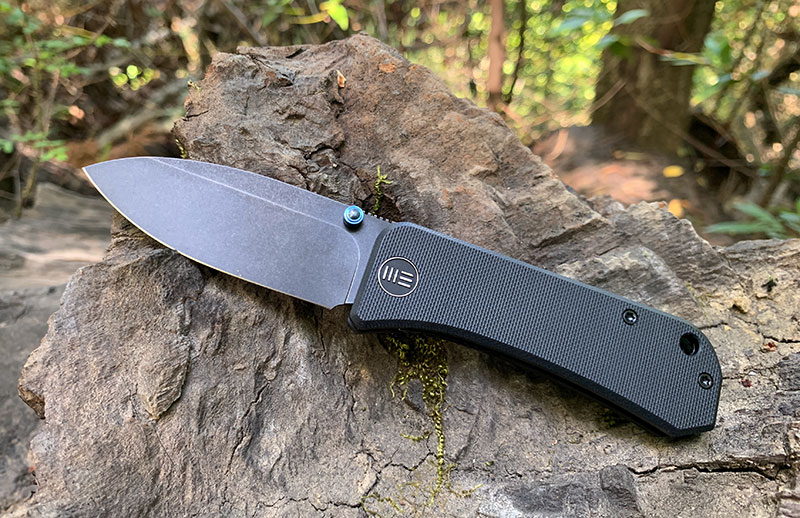
Sounds fine on paper, but there are two inherent issues with this design choice, in my estimation. One, is that it can be a little uncomfortable in use, especially when it has scallops, or light jimping on the liner lock. And the second, is that when I’m gripping the knife to cut something like a small sheet of cardboard, I can feel the liner moving around on my index finger. And, in some cases, this causes the blade to have just a touch of play while the knife is gripped in-hand. The last thing I want my folder to do, is to close on my hand.
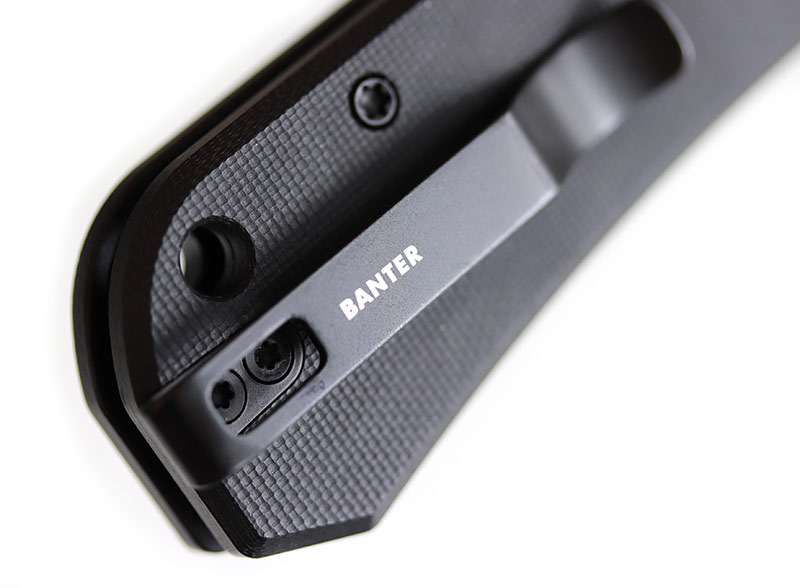
Now, in normal EDC type scenarios, this isn’t a big deal. But on some knives, for example the North Arm Skaha II, I can manipulate the blade with my thumb on the jimping just by gripping the knife normally, with a little squeeze. And the Banter will do this as well, albeit more subtly. I understand the design philosophy of this knife is not ultimate hard use, stab through trees, and pry apart pallets. But, for me, I don’t like feeling the lock moving around while I use the knife, period.
Features, Fit and Finish
As you may have guessed, the fit and finish of the Banter is pretty damn good. There are many more features on this knife than meets the eye. Let’s start with the handle. We’re greeted with some of the most aptly finished G10 texture I’ve had the pleasure of handling and using. It’s just grippy enough to stay in your hand when you give it a little squeeze, but smooth enough to get in and out of the pocket without shredding those precious pocket seams. And to compliment the feel of the G10 even more, is some very generous chamfering around the edges.
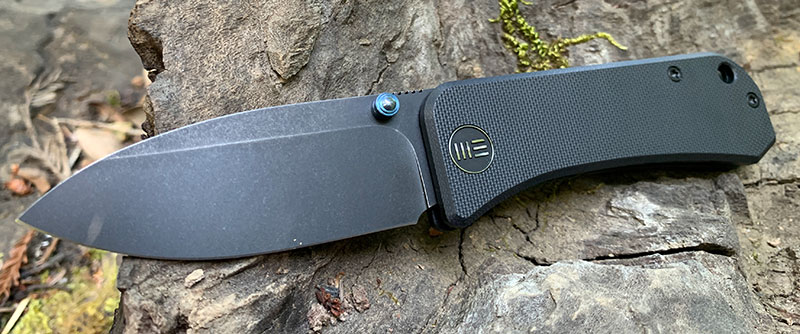
The show side scale has a lanyard hole (without the tube, another good decision here, as they tend to make disassembly more difficult, the “WE Knives” logo on the pivot, and two exposed body screws. On the lock side scale, we are presented with a very cleanly recessed pivot screw, one body screw, and the pocket clip. Pocket clips on folders rarely get lots of attention, but it’s an aspect of the knife that I think makes a big difference in using and carrying the knife. Ben made some great choices here on the clip.
In his recent Instagram Live “Banter Eve” video, he made a point to talk about the clip, too. The design came from a small Protech model, with some modifications. He made sure to design the clip with recessed screws, so that the screw heads don’t snag on the pocket when being drawn out or re-pocketed. This kind of attention to detail is so refreshing. It’s subtle, just like every other part of this boxy little knife, and it’s great.
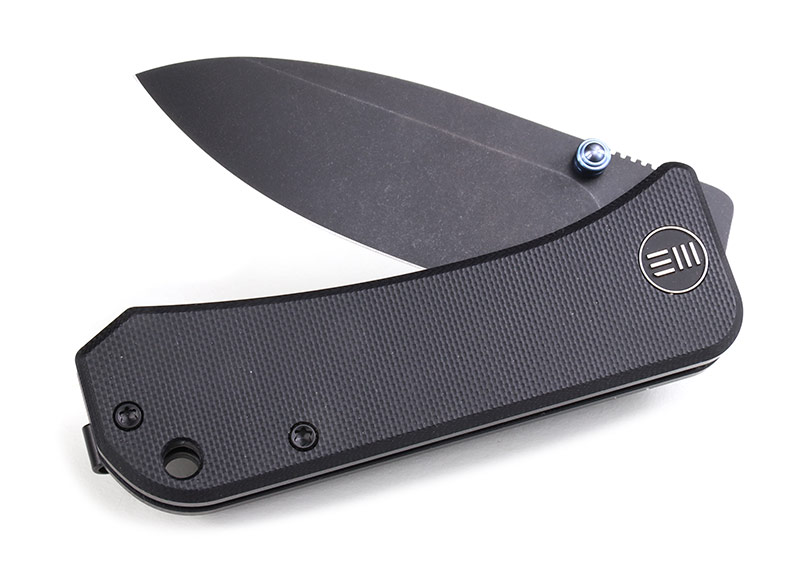
The clip also has very good retention, and doesn’t move around in the hand when using the knife. Some deep carry clips, like the wire clip on some of Spyderco’s models, has a ton of flex to it when using the knife. But with a recessed cutout for the clip itself in the G10, and the recessed screws, it’s very clean and smooth, while still feeling just as solid as a traditionally mounted clip. The model name, Banter, is etched on the clip, which are the first letters of all Ben’s family members. What a great tribute to his family, while simultaneously keeping the YouTube videos origin alive. And it rides deep, too. Just below the pocket line, but not so deep that it’s difficult to remove the knife from the pocket.
Under the hood, things remain simple, clean, and precise. If I’m going to buy a knife that rides on bearings, I indefinitely prefer ceramic. And the Banter uses not only caged ceramic bearings, but also a ceramic detent ball. These are just great choices, usually reserved for higher end knives upwards of $200-500. The blade has recessed pockets for the bearings, and the handle scales have nested, partial liners near the pivot, to ensure longevity for even the most fidgety individuals. And the pivot is also held in place by a flat portion, so removing or tightening the pivot screw is never going to be a problem. Unless, of course, you violate knife rule #107: the use of red Loctite.
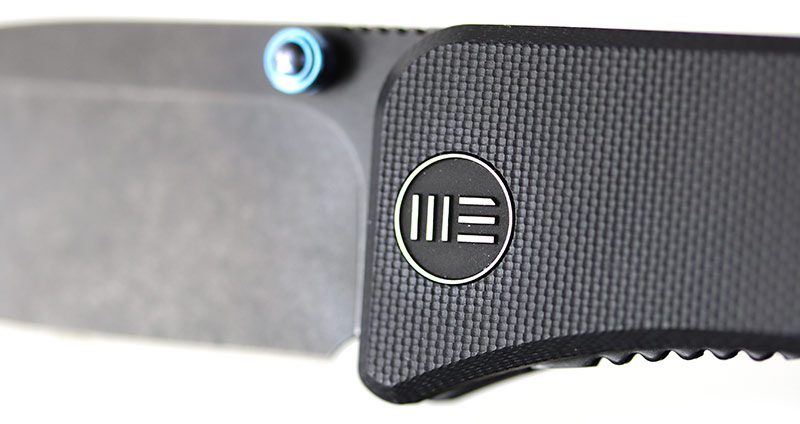
The thumb studs, which we previously talked about as having a very comfortable feel, are anodized titanium. So on this modest little $108 folder, you get a thumb stud that has the same material and anodization as the infamous $475 Sebenza, but on both sides of the blade, for no extra charge, and they’re more comfortable. Yes, they will lose a little color over time, but “Ben Blue” is a color that just has to exist on anything purchased, designed, or worn on the body by Sir Ben Petersen.
Field Test
With an emphasis on EDC, the Banter is about as true to form as it gets. It’s light, carries nearly invisibly, keeps itself legal in just about any jurisdiction, flips closed with ease, and drops back in the pocket and out of the way. This is what an everyday carry knife should do; be forgotten until needed, then easily forgotten again. Of course, us knife nerds never forget which knife (or knives…) we are carrying, but an unobtrusive piece of gear is greatly appreciated for any urban EDC fanatic.

So, in my usual fashion, I put the Banter up against the usual suspects; apples, cardboard, and 2×4’s. And the Banter is great at just about all of it, with a couple caveats.
We all have our own method of slicing up food, and specifically for this test, I use apples. The cuts made in an apple by a knife will give you a good idea of the cutting performance dictated by the blade geometry. And, while the Banter has a grind that’s coupled with a stock thickness that lends itself well to food prep, the blade is a bit short. For me, I like to slice the side of the apple off first, and the Banter left me with a good 1/4 of the apple to finish cutting on the other side. Again, not a huge deal, but short blades have their limitations. And, with the thumb stud deployment on this little slicer in the cutting path (albeit just slightly), it shaves down the usable cutting edge even more. I understand this is not an inherently bad thing. Many people focusing on a capable EDC knife are not looking for much more blade than what’s offered here. But with my testing, this is what I found.
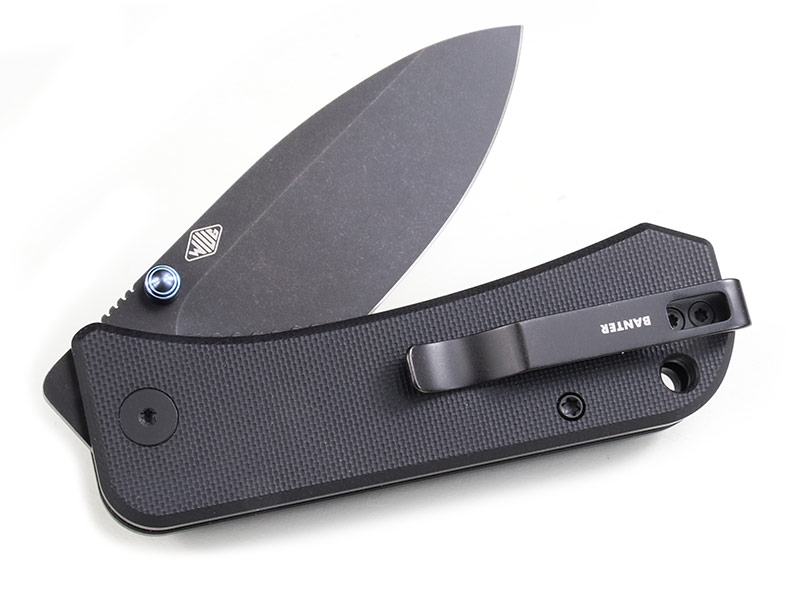
Cutting cardboard was not much different than the apple test for my use. Cutting open a small box with the Banter is great; you get a small knife that has a great blade, that can be pulled from your pocket quickly, flicked open, make the cut, and put the knife away. And that’s where the Banter is most at-home. But when I started to break down a couple medium sized boxes, I found myself a little frustrated. The handle is just too short to get a solid grip on, for my hand. The G10 is very well done, and feels great in the hand. The boxy design of the Banter fills the hand great for such a small overall knife. But the handle length is quite short, at 3.6”. I feel that I have to either get my hand closer to the blade than that handle allows, or have my pinky hanging off the knife, to get a solid grip.
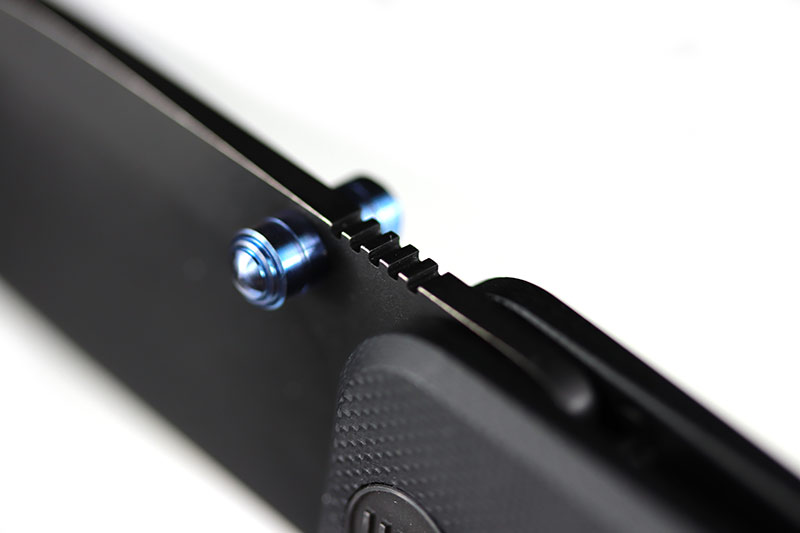
Again, I understand this knife isn’t designed to be an all-out camping knife companion for batoning logs for a fire. But I get short changed a little in the ergo’s of this knife for light duty tasks like this. And, back to the issue of the liner lock, the cardboard cutting is where I found myself feeling the liner push over on my index finger while making cuts. Now, I don’t use my knife with pressure against the spine of the blade, but I have a little loss of reassurance when I feel the lock slightly moving around when using the knife. And, the jimping on that liner also digs into the index finger as well.
Shaving down some feather sticks on the 2×4 was no problem. With the thinness behind the edge, and the tall flat grind of the blade, it cuts well for things like this. The blade will sometimes get in its own way on some knives, if the grind is too thick behind the edge. In those instances, the shoulder just behind the edge will push the edge of the blade off the material. Not the case here, the Banter can take fine cutting tasks with not issue. But, just like the cardboard, giving the handle a light squeeze, and digging into the wood just a little, presented me with all the ergonomic issues I had with the cardboard. The handle is short for my hand (I wear large sized gloves, pretty standard sized hands), and the lock just gets in the way.

Ben talked about how his initial design of the Banter was going to have an axis style lock, like Benchmade’s. The patent is up for that lock here in the USA, but apparently, in China (where the Banter is produced by WE Knife), that lock style is not open source as of now. And We, having the integrity they do, said they will not make the axis style lock on their knives. So, in the case that we would’ve had an axis lock on this knife, one of the ergonomic issues I have wouldn’t be present. But, the short handle just seems to leave me wishing for just a little more real estate
Alternatives
All these knives available at BladeHQ.
Civivi Knives, WE Knife’s parent company, recently came out with a small flipper that rivals the Banter in many ways. That knife is the Elementum. This knife has more available configurations than I was able to count, and ranges in price from about $50 to around $100. It’s made (most likely) in the same factory as the Banter, has a very similar overall size, also runs on bearings and uses a liner lock. The Elementum gained traction quickly when it was released, and has been difficult for online retailers to keep them in stock until recently. I believe the Elementum to have the same philosophy of use, as a small EDC knife that flips open nicely, makes a cut when it needs to, and tucks away back in the pocket thanks to its deep carry clip. The blade steel ranges from Damascus, to D2, S35VN, and the handle scale inlays range from Micarta, to G10, to copper, marble carbon fiber, brass, and others. Very comparable knife, but with tons of options, at a slightly lower price point.
The Spyderco Lil Native is another small knife with some fidget-friendly attributes. The compression lock that Spyderco uses on many of their knives is known to be strong, and gives the user the capability to unlock and close the blade without ever having a digit in the path of the blade. The Lil Native is popular enough that Spyderco has made many variants in its sprint run program, so it can be had in many steels from Rex 45, to 4V, and many others. But, of course, this is mainly only on the secondary market now, as the sprint run knives only sell as a one-time production. But, the standard S30V, G10 model is evergreen, so it’s availability is plentiful. It is smaller, with only a 2.5” blade, and an overall length of 5.9”, but is still a viable option in comparison to the Banter. The Lil Native also comes with a wire-style deep carry clip, for the utmost discreet carry. It’s also available in a back lock variant, if you prefer that lock style rather than the compression lock.

And, for my favorite of the three comparisons to the Banter, is the Benchmade Bugout. I think, personally, the Bugout is the best option in this list of knives. It has just a little more blade length, coming in at 3.24”, an overall length of 7.46”, and a surprising low weight of 1.85 oz. It utilizes a small, deep carry clip as well, and has a little more handle to fill out a full grip, but keeps a very thin profile. Of all the knives I’ve had in my hand in the last decade or so, the Bugout has one of the best overall blades I’ve ever used. It’s good at anything you need out of it, and the S30V blade seems to be heat treated especially well. With a great lifetime warranty, the ~$125 price tag seems maybe a little on the high side for flexible handle scales and an axis lock, but in my opinion it’s worth the money. For my tastes, the Bugout is a better overall knife for the money when compared to the $108 that the Banter is asking for. And, the aftermarket has exploded with options for Bugouts, for good reason.

Conclusion
I truly wish I could’ve found only positive things to say about my use with the Banter. It’s a knife that many folks in the knife community will have a personal connection with, knowing who Ben Petersen is, and knowing his constant positive attitude. The Banter is a good knife, without a doubt. But I can’t say it’s great. It’s very simple, affordable, built very well, and comes in a sweet little package for everyday carry situations.
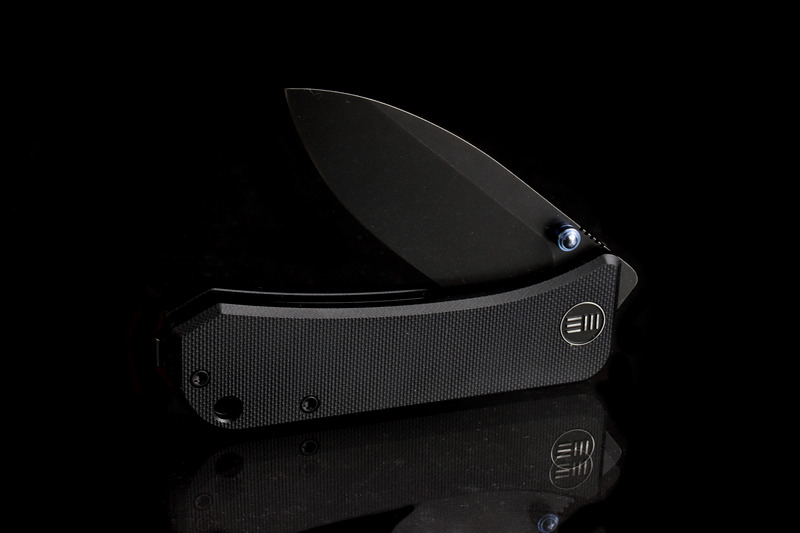
It has a great steel choice for its intended use, and tucks away in the pocket in a way that allows you to forget about it until you need it. It’s designed by a guy who is easy to like, and support. But the short handle and odd lock placement gave the knife a feel of little confidence in the hand. If your use never consists of putting much intensity on your knife, this may be a great choice for you. But on balance it’s tough to beat the Bugout as a light duty folder.
- Great build quality, carries stealthily, simplicity executed admirably, solid value.
- Short and boxy handle, liner lock can be pesky.
WE Knife Banter
Quality/Performance - 74%
Value for Money - 86%
80%
A valiant debut effort from newcomer Ben Petersen, the Banter competes admirably and represents great value for money.





